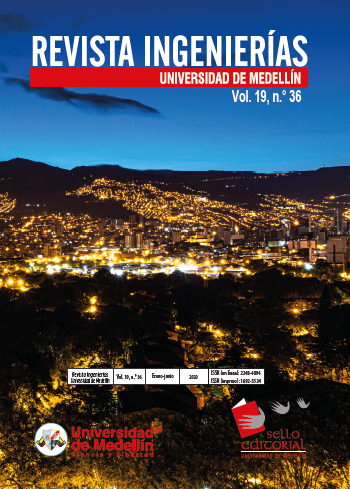Derechos de autor 2023 Revista Ingenierías Universidad de Medellín

Esta obra está bajo licencia internacional Creative Commons Reconocimiento-NoComercial-SinObrasDerivadas 4.0.
- Articles
- Enviado: octubre 22, 2018
-
Publicado: junio 28, 2019
Resumen
La capacidad de concentración de un niño depende de su edad y lo normal es que a medida que crece, aumenta este tiempo de atención; sin embargo, es importante trabajar esta capacidad desde edades tempranas. Los clásicos juegos de mesa como ajedrez, laberintos, triqui, rompecabezas, etc., requieren cierta cantidad de procesos mentales para ser jugados y son ideales para mantener la atención del niño durante varios minutos. El presente proyecto es una propuesta innovadora a través del procesamiento de imágenes y algoritmos de búsqueda por anchura, resuelve laberintos físicos creados por los jugadores. La efectividad obtenida fue de un 72 %, se recalca que la calidad del sensor y el ángulo en el cual se toma la fotografía influyen enormemente.
Referencias
- [1] F. Siebert, “Un tercio de los niños diagnosticados con déficit atencional son hijos de padres que lo padecieron - Universidad de Chile”, [En línea], acceso 23 de marzo 2018; Disponible: http://www.uchile.cl/noticias/131342/origenes-y-pronostico-del-deficit-atencional-en-ninos
- [2] C. Felfe y R. Lalive, “Does early child care affect children’s development?”, J. Public Econ., vol. 159, pp. 33–53, [En línea], acceso marzo 2018; Disponible:https://doi.org/10.1016/j.jpubeco.2018.01.014.
- [3] “Juguetes de madera: beneficio de los laberintos”. [En línea], acceso 23 marzo 2018; Disponible: https://juguetutto.com/blog/2016/01/29/por-que-regalar-laberintos-de-madera/
- [4] A. Oren, “Children’s Use of Board Games in Psychotherapy” Journal of Child Psychotherapy, [En línea], vol 34, pp. 364-383, dec. 2008; Disponible: http://dx.doi.org/10.1080/00754170 802472893
- [5] J. P. Hinebaugh, A Board Game Education. Maryland, Estados Unidos: R&L Education, 2009.
- [6] J. Begy, “Board Games and the Construction of Cultural Memory”, Games Cult., 2015. [En línea]; Disponible: https://doi.org/10.1177%2F1555412015600066
- [7] W.-J. Chou, Y.-P. Chang, y C.-F. Yen, “Boredom proneness and its correlation with Internet addiction and Internet activities in adolescents with attention-deficit/hyperactivity disorder”, Kaohsiung J. Med. Sci., [En línea], acceso febrero 2018; Disponible: https://doi.org/10.1016/j.kjms.2018.01.016
- [8] C. F. Cortés, J. Giraldo, C. A. Pérez, A. Torres y C. A. Vega, “Móvil con búsqueda de trayectoria en laberinto”, Escuela Colombiana de Ingeniería Julio Garavito. December 2008, 2015.
- [9] M. O. A. Aqel, A. Issa, M. Khdair, M. ElHabbash, M. AbuBaker, and M. Massoud, “Intelligent Maze Solving Robot Based on Image Processing and Graph Theory Algorithms”, in 2017 International Conference on Promising Electronic Technologies (ICPET), 2017, [En línea], pp. 48–53; Disponible: https://doi.org/10.1109/ICPET.2017.15.
- [10] “MAZE3D: Un juego de computadora para la estimulación de la orientación espacial / MAZE3D: A computer game for improve spatial orientation | Osorio Josué | RIDE Revista Iberoamericana para la Investigación y el Desarrollo Educativo”, [En línea] acceso 24 marzo 2018; Disponible: https://www.ride.org.mx/index.php/RIDE/article/view/147/646https://doi.org/10.23913/ride.v6i11.147.
- [11] J. Grompone, El paradigma del laberinto, Montevideo, Uruguay: La Flor del Itapebi, 2011.
- [12] C. Jarvis, “Active Launceston launches Active Technology at East Tamar Primary School”, The Examiner News, n.°, 2017, [En línea], acceso 24 marzo 2018; Disponible: https://www.examiner.com.au/story/4641347/technology-used-to-inspire-active-kids/
- [13] M. Azizinezhad y M. Hashemi, “Technology as a Medium for Applying Constructivist Teaching Methods and Inspiring Kids”, Procedia - Soc. Behav. Sci., [En línea], vol. 28, pp. 862–866, acceso enero 2011; Disponible: htt ps://doi.org/10.1016/j.sbspro.2011.11.158
- [14] S. Hojjat, C. Fukuzaki, y T. Sowa, “Maze and Mirror Game Design for Increasing Motivation in Studying Science in Elementary School Students”, 2017, [En línea], pp. 55–64; Disponible: http://dx.doi.org/10.1007/978-3-319-55834-9_7
- [15] J. A. Verkhoturova, J. N. Galaguzova, y N. N. Sergeeva, “The Technique of Game Skills Development for Parents Raising Young Children”, Procedia - Soc. Behav. Sci., [En línea], vol. 233, pp. 150-154, acceso octubre 2016; Disponible: https://doi.org/10.1016/j.sbspro.2016.10.174
- [16] V. F. Gabdulkhakov, “A Didactic Game Technology”, Procedia - Soc. Behav. Sci., [En línea], vol. 233, pp. 170–174, acceso octubre 2016; Disponible: htt ps://doi.org/10.1016/j.sbspro.2016.10.187
- [17] C. T. Leondes, Image Processing and Pattern Recognition, San Diego, Estados Unidos: Academic Press, 1998.
- [18] S. Jayaraman, Digital Image Processing. Tata McGraw-Hill Education, 2011.
- [19] A. Zelinsky, “Learning OpenCV-Computer Vision with the OpenCV Library (Bradski, G.R. et al.; 2008) [On the Shelf]”, IEEE Robot. Autom. Mag., [En línea], vol. 16, n.° 3, p. 100, 2009; Disponible: https://doi.org/10.1109/MRA.2009.933612.
- [20] S. Kagami, “Utilizing OpenCV for High-Speed Vision Processing”, Adv. Robot., [En línea], vol. 31, n.° 3, pp. 244–248, 2013; Disponible: https://doi.org/10.7210/jrsj.31.244
- [21] N. J. Nilsson, Inteligencia artificial: una nueva síntesis, Madrid, España: Mc Graw Hill, 2001.
- [22] A. García, Inteligencia artificial: fundamentos, práctica y aplicaciones. Madrid, España: RC Libros, 2012.
- [23] A. Freeman, “Creating Mobile Web Apps”, Pro JavaScript for Web Apps, 2012, [En línea], pp. 195–228; Disponible: htt ps://doi.org/10.1007/978-1-4302-4462-2_8



















